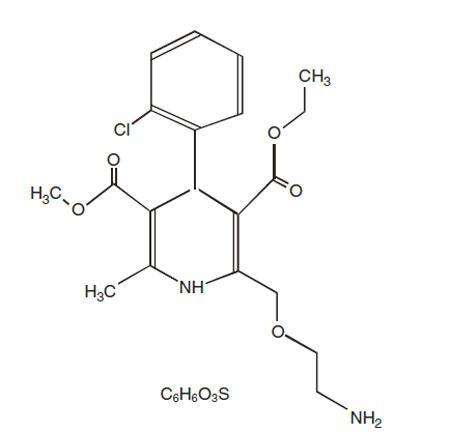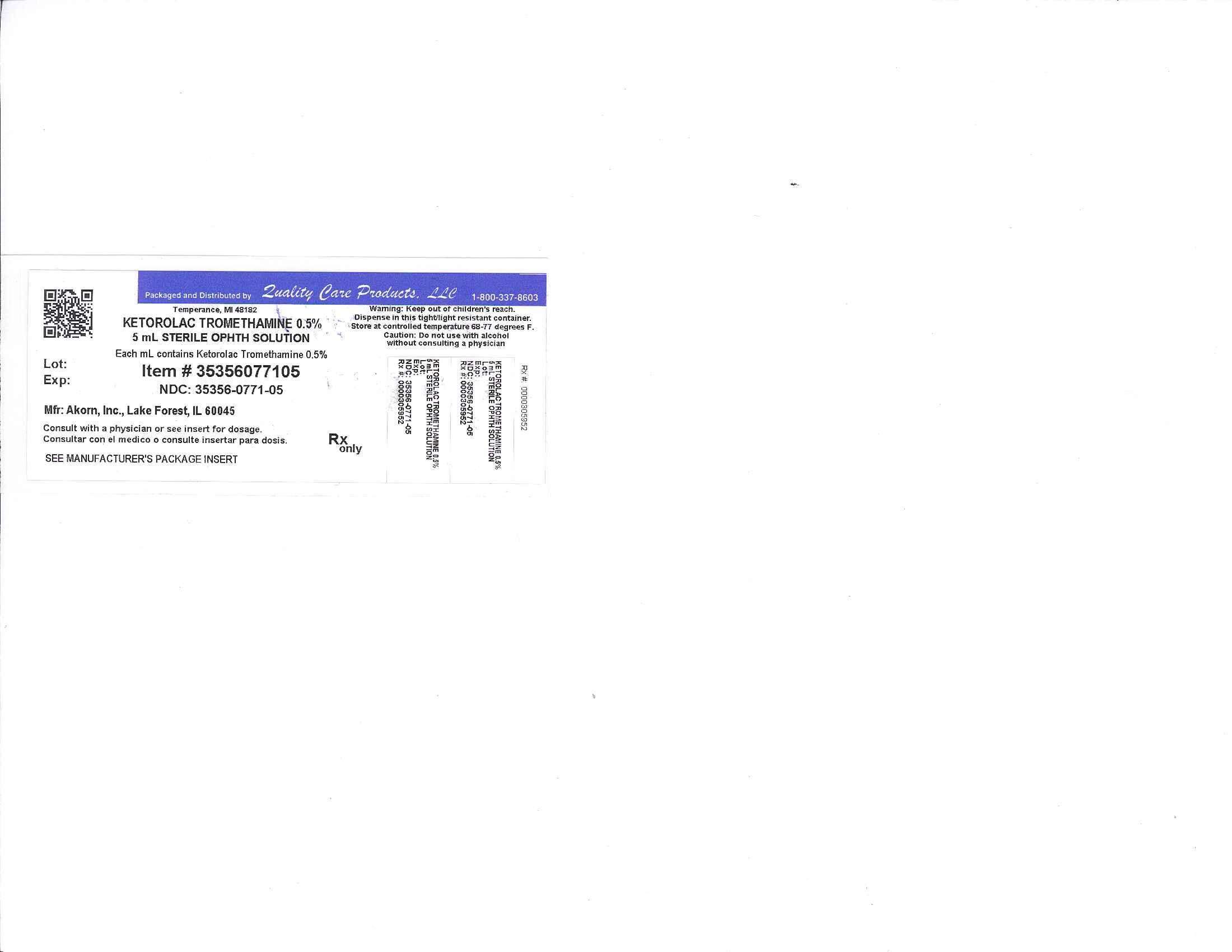Ketorolac Tromethamine
Lake Erie Medical DBA Quality Care Products LLC
Ketorolac Tromethamine Ophthalmic Solution, 0.5%
FULL PRESCRIBING INFORMATION: CONTENTS*
- KETOROLAC TROMETHAMINE DESCRIPTION
- CLINICAL PHARMACOLOGY
- KETOROLAC TROMETHAMINE INDICATIONS AND USAGE
- KETOROLAC TROMETHAMINE CONTRAINDICATIONS
- WARNINGS
- PRECAUTIONS
- KETOROLAC TROMETHAMINE ADVERSE REACTIONS
- KETOROLAC TROMETHAMINE DOSAGE AND ADMINISTRATION
- HOW SUPPLIED
- Image of Label
FULL PRESCRIBING INFORMATION
Sterile
Rx only
DESCRIPTION
Ketorolac Tromethamine Ophthalmic Solution is a member of the pyrrolo-pyrrole group of nonsteroidal anti-inflammatory drugs (NSAIDs) for ophthalmic use. Its chemical name is (±)-5-benzoyl-2, 3-dihydro-1H pyrrolizine-1-carboxylic acid, compound with 2-amino-2-(hydroxymethyl)-l,3-propanediol(1:1) and it has the following structural formula:

The molecular formula of Ketorolac Tromethamine Ophthalmic Solution is C15H13NO3•C4H11NO3.
Ketorolac Tromethamine Ophthalmic Solution is supplied as a sterile isotonic aqueous 0.5% solution, with a pH of 7.4.
Ketorolac Tromethamine Ophthalmic Solution is a racemic mixture of R-(+) and S-(-)- ketorolac tromethamine.
Ketorolac tromethamine may exist in three crystal forms. All forms are equally soluble in water. The pKa of ketorolac is 3.5. This white to off-white crystalline substance discolors on prolonged exposure to light. The molecular weight of ketorolac tromethamine is 376.41. The osmolality of Ketorolac Ophthalmic Solution is 290 mOsml/kg.
Each mL of Ketorolac Tromethamine Ophthalmic Solution contains:
Active: ketorolac tromethamine 0.5%
Preservative: benzalkonium chloride 0.01%
Inactives: edetate disodium 0.1%; octoxynol 40; sodium chloride; hydrochloric acid and/or sodium hydroxide may be added to adjust the pH (6.8-7.4) and purified water.
CLINICAL PHARMACOLOGY
Ketorolac tromethamine is a nonsteroidal anti-inflammatory drug which, when administered systemically, has demonstrated analgesic, anti-inflammatory, and anti-pyretic activity.
The mechanism of its action is thought to be due to its ability to inhibit prostaglandin biosynthesis. Ketorolac tromethamine given systemically does not cause pupil constriction.
Prostaglandins have been shown in many animal models to be mediators of certain kinds of intraocular inflammation. In studies performed in animal eyes, prostaglandins have been shown to produce disruption of the blood-aqueous humor barrier, vasodilation, increased vascular permeability, leukocytosis, and increased intraocular pressure. Prostaglandins also appear to play a role in the miotic response produced during ocular surgery by constricting the iris sphincter independently of cholinergic mechanisms.
Two drops (0.1 mL) of 0.5% Ketorolac Tromethamine Ophthalmic Solution instilled into the eyes of patients 12 hours and 1 hour prior to cataract extraction achieved measurable levels. In 8 of 9 patients' eyes (mean ketorolac concentration 95 ng/mL aqueous humor, range 40 to 170 ng/mL). Ocular administration of ketorolac tromethamine reduces prostaglandin E2 (PGE2) levels in aqueous humor. The mean concentration of PGE2 was 80 pg/mL in the aqueous humor of eyes receiving vehicle and 28 pg/mL in the eyes receiving ketorolac ophthalmic solution, 0.5%.
One drop (0.05 mL) of 0.5% Ketorolac Tromethamine Ophthalmic Solution was instilled into one eye and one drop of vehicle into the other eye TID in 26 normal subjects. Only 5 of 26 subjects had a detectable amount of ketorolac in their plasma (range 10.7 to 22.5 ng/mL) at Day 10 during topical ocular treatment. When ketorolac tromethamine 10 mg is administered systemically every 6 hours, peak plasma levels at steady state are around 960 ng/mL.
Two controlled clinical studies showed that Ketorolac Tromethamine Ophthalmic Solution was significantly more effective than its vehicle in relieving ocular itching caused by seasonal allergic conjunctivitis.
Two controlled clinical studies showed that patients treated for two weeks with Ketorolac Tromethamine Ophthalmic Solution were less likely to have measurable signs of inflammation (cell and flare) than patients treated with its vehicle.
Results from clinical studies indicate that ketorolac tromethamine has no significant effect upon intraocular pressure; however, changes in intraocular pressure may occur following cataract surgery.
INDICATIONS AND USAGE
Ketorolac Tromethamine Ophthalmic Solution is indicated for the temporary relief of ocular itching due to seasonal allergic conjunctivitis. Ketorolac Tromethamine Ophthalmic Solution is also indicated for the treatment of postoperative inflammation in patients who have undergone cataract extraction.
CONTRAINDICATIONS
Ketorolac Tromethamine Ophthalmic Solution is contraindicated in patients with previously demonstrated hypersensitivity to any of the ingredients in the formulation.
WARNINGS
There is the potential for cross-sensitivity to acetylsalicylic acid, phenylacetic acid derivatives, and other nonsteroidal anti-inflammatory agents. Therefore, caution should be used when treating individuals who have previously exhibited sensitivities to these drugs.
With some nonsteroidal anti-inflammatory drugs, there exists the potential for increased bleeding time due to interference with thrombocyte aggregation. There have been reports that ocularly applied nonsteroidal anti-inflammatory drugs may cause increased bleeding of ocular tissues (including hyphemas) in conjunction with ocular surgery.
PRECAUTIONS
General: All topical nonsteroidal anti-inflammatory drugs (NSAIDs) may slow or delay healing. Topical corticosteroids are also known to slow or delay healing. Concomitant use of topical NSAIDS and topical steroids may increase the potential for healing problems.
Use of topical NSAIDs may result in keratitis. In some susceptible patients, continued use of topical NSAIDs may result in epithelial breakdown, corneal thinning, corneal erosion, corneal ulceration or corneal perforation. These events may be sight threatening. Patients with evidence of corneal epithelial breakdown should immediately discontinue use of topical NSAIDs and should be closely monitored for corneal health.
Postmarketing experience with topical NSAIDs suggests that patients with complicated ocular surgeries, corneal denervation, corneal epithelial defects, diabetes mellitus, ocular surface diseases (e.g., dry eye syndrome), rheumatoid arthritis, or repeat ocular surgeries within a short period of time may be at increased risk for corneal adverse events which may become sight threatening. Topical NSAIDs should be used with caution in these patients.
Postmarketing experience with topical NSAIDs also suggests that use more than 24 hours prior to surgery or use beyond 14 days post-surgery may increase patient risk for the occurrence and severity of corneal adverse events.
It is recommended that Ketorolac Tromethamine Ophthalmic Solution be used with caution in patients with known bleeding tendencies or who are receiving other medications which may prolong bleeding time.
Information for Patients: Ketorolac Tromethamine Ophthalmic Solution should not be administered while wearing contact lenses.
Carcinogenesis, Mutagenesis, and Impairment of Fertility:
Ketorolac tromethamine was not carcinogenic in rats given up to 5 mg/kg/day orally for 24 months (151 times the maximum recommended human topical ophthalmic dose, on a mg/kg basis, assuming 100% absorption in humans and animals) nor in mice given 2 mg/kg/day orally for 18 months (60 times the maximum recommended human topical ophthalmic dose, on a mg/kg basis, assuming 100% absorption in humans and animals).
Ketorolac tromethamine was not mutagenic in vitro in the Ames assay or in forward mutation assays. Similarly, it did not result in an in vitro increase in unscheduled DNA synthesis or an in vivo increase in chromosome breakage in mice. However, ketorolac tromethamine did result in an increased incidence in chromosomal aberrations in Chinese hamster ovary cells.
Ketorolac tromethamine did not impair fertility when administered orally to male and female rats at doses up to 272 and 484 times the maximum recommended human topical ophthalmic dose, respectively, on a mg/kg basis, assuming 100% absorption in humans and animals.
Pregnancy: Teratogenic Effects: Pregnancy Category C. Ketorolac tromethamine, administered during organogenesis, was not teratogenic in rabbits or rats at oral doses up to 109 times and 303 times the maximum recommended human topical ophthalmic dose, respectively, on a mg/kg basis assuming 100% absorption in humans and animals. When administered to rats after Day 17 of gestation at oral doses up to 45 times the maximum recommended human topical ophthalmic dose, respectively, on a mg/kg basis assuming 100% absorption in humans and animals, ketorolac tromethamine resulted in dystocia and increased pup mortality. There are no adequate and well-controlled studies in pregnant women. Ketorolac Tromethamine Ophthalmic Solution should be used during pregnancy only if the potential benefit justifies the potential risk to the fetus.
Nonteratogenic Effects: Because of the known effects of prostaglandin-inhibiting drugs on the fetal cardiovascular system (closure of the ductus arteriosus), the use of Ketorolac Tromethamine Ophthalmic Solution during late pregnancy should be avoided.
Nursing Mothers: Caution should be exercised when Ketorolac Tromethamine Ophthalmic Solution is administered to a nursing woman.
Pediatric Use: Safety and efficacy in pediatric patients below the age of 3 have not been established.
Geriatric Use: No overall differences in safety or effectiveness have been observed between elderly and younger patients.
ADVERSE REACTIONS
The most frequent adverse events reported with the use of ketorolac ophthalmic solution have been transient stinging and burning on instillation. These events were reported by up to 40% of patients participating in clinical trials.
Other adverse events occurring approximately 1% - 10% of the time during treatment with ketorolac ophthalmic solution including allergic reactions, corneal edema, iritis, ocular inflammation, ocular irritation, superficial keratitis, and superficial ocular infections.
Other adverse events reported rarely with the use of ketorolac tromethamine ophthalmic solutions included corneal infiltrates, corneal ulcer, eye dryness, headaches, and visual disturbance (blurry vision).
Clinical Practice: The following events have been identified during postmarketing use of ketorolac tromethamine ophthalmic solution 0.5% in clinical practice. Because they are reported voluntarily from a population of unknown size, estimates of frequency cannot be made. The events, which have been chosen for inclusion due to either their seriousness, frequency of reporting, possible causal connection to topical ketorolac tromethamine ophthalmic solution 0.5%, or a combination of these factors, including corneal erosion, corneal perforation, corneal thinning and epithelial breakdown (see PRECAUTIONS, General ).
DOSAGE AND ADMINISTRATION
The recommended dose of Ketorolac Tromethamine Ophthalmic Solution is one drop (0.25 mg) four times a day for relief of ocular itching due to seasonal allergic conjunctivitis.
For the treatment of postoperative inflammation in patients who have undergone cataract extraction, one drop of Ketorolac Tromethamine Ophthalmic Solution should be applied to the affected eye(s) four times daily beginning 24 hours after cataract surgery and continuing through the first 2 weeks of the postoperative period.
Ketorolac Tromethamine Ophthalmic Solution has been safely administered in conjunction with other ophthalmic medications such as antibiotics, beta blockers, carbonic anhydrase inhibitors, cycloplegics, and mydriatics.
HOW SUPPLIED
Ketorolac Tromethamine Ophthalmic Solution is supplied sterile in white LDPE plastic bottles with natural droppers and gray short skirt caps as follows:
5 mL in l0 mL bottle - NDC 35356-771-05
Store at 20° to 25°C (68° to 77°F) [see USP Controlled Room Temperature].
Protect from light. Retain in carton until time of use.
Rx only
Manufactured by: Akorn, Inc.
Lake Forest, IL 60045
KR00N Rev.07/09
Image of Label

Ketorolac Tromethamineketorolac tromethamine SOLUTION
| |||||||||||||||||||||||||||||||||||||||||||||||||||||||||||||||||||||||||